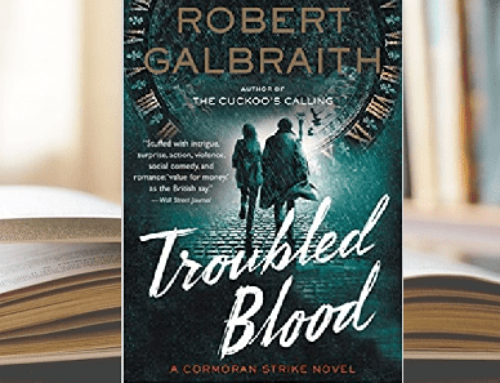[by Ross Browne]
When You Find Me was, without a doubt, one of the most pleasant literary surprises I’ve had in a long time. It’s a debut novel that got a warm reception from readers and critics alike, and with good reason. It’s a Southern gothic-style thriller with an inventive plotline, a riveting psychological twist told in a lovely writing style with enough police procedure and sleuthing to satisfy hardcore mystery fans such as myself, even though it’s not a traditional mystery. With a Southern setting rendered convincingly but subtly (no one’s drinking mint juleps on the veranda here), a compassionate but unflinching look at addiction, and deft handling of an unreliable narrator, it’s a complex, deeply absorbing novel that satisfies on a lot of levels.
I’ll sidestep most of the lavish praise I think this book deserves on other fonts and focus solely on one of its most notable attributes: the character of Detective Nina Palmer of the Elizabeth County Sheriff’s Office.
Nina is young, black, smart, and a lifelong resident of the rural South Carolina town where the story takes place. She knows the key players and has enough history with some of them to complicate things in interesting ways.
A different kind of detective
One thing I admire so much about the author’s rendering of Nina is how immediately different she comes across from most detectives you meet in crime fiction. She’s a series-worthy cop who throws a long shadow over this complex, braided narrative without stealing the show from other key characters. While I can only speculate as to Mr. Vernon’s intentions, I found plenty to appreciate in his fresh and imaginative rendering of the story’s cop protagonist.
Readers first meet Nina in Chapter 4. She is the third viewpoint character introduced in the story, all of whom are written in the first person. This unusual choice works quite well, I think. Readers always know whose POV (point of view) we’re in thanks to the chapter headings.
Anyhow, Nina’s first observation in the very first line of the chapter where she’s introduced is that “winters in Elizabeth, South Carolina are rarely cold enough to kill the crickets.”
It’s a small thing, I suppose, but so refreshing and different from the way police and detectives are usually introduced in crime fiction. The scene follows Nina as she checks the mail for her aged aunt Tilda (who’s dying of cancer) and sets about the daily business of doing what she can to provide comfort to a woman she clearly loves.
The events of this chapter have little to do with Nina’s persona as a cop and appear to have nothing to do with the book’s main plot. (Though we’ll learn later that a clue to a dark truth at the center of the story is discovered by Nina in this scene.) Instead, these opening pages focus mostly on the care and nurture Nina provides to her aunt. Along the way, readers get a compelling introduction to a principled and strong-willed woman with a nose for sniffing out when something isn’t right. The chapter closes with Tilda in a morphine-induced sleep while Nina researches a news item and wonders why the hell a wealthy Carolina family (whose patriarch failed in his political ambitions) would still be sending her aunt checks years after Tilda stopped working for them.
In six short pages, readers are treated to a lovely rendering of a different kind of cop in a different kind of cop story. The crime that sets the events of the novel into motion hasn’t happened yet, but the detective who will lead the investigation when the time comes is introduced with imaginative flair.
We reconnect with Nina two chapters later as she makes her way to work on Christmas morning. Here, readers encounter the first and perhaps only moment that focuses on her experience of being a black woman working in an office full of white males. Given that this is Deep South, you might expect the novel to make more of this–or the challenges Nina might face being black and female in a Sheriff’s department full of good ol’ boys. That it doesn’t is unexpected and pleasing.
While there are challenges, of course, Nina does not see herself as a victim. The fact that she’s black does come up, but mainly in the context of her memory about being in school with Gray King (whose husband’s disappearance is central to the story) back when they were kids. Gray did manage to insult Nina by rejecting a kind overture in a way she perhaps wouldn’t have from a white student, but without any overt hostility or racist sentiment.
Interestingly, her memory of this ends with a surprising act of contrition on Gray’s part where she offers an apology that Nina is quick to accept. This sets a very different tone than what I often find in Southern-set crime stories, and the way the issue of race and gender is handled in Vernon’s novel is refreshing. Ditto for the fact that Nina’s partner is a gay man who’s out of the closet. This makes the novel feel smartly contemporary–like these things aren’t big deals anymore and shouldn’t matter much to anyone. Had Nina been white or her partner straight, the story could have unfolded in pretty much the same way. All good!
Anyhow, by the time Nina’s second chapter ends, readers learn that an abandoned vehicle has been found belonging to Gray’s husband, the son-in-law of the woman writing these unexplained checks Aunt Tilda’s is receiving! This is a man who married into Elizabeth, SC’s most prominent family and hopes to succeed in politics where his father-in-law failed.
We watch as Nina makes a regrettable choice that delays a missing person’s alert. She makes a questionable (but not entirely unreasonable) decision despite her intuition telling her that something is wrong here. It’s a choice that comes back to haunt her later in the book and will have her question her own subconscious motives in a surprising way. But it’s a mistake she totally owns and insists on making right.
Vernon’s rendering of Nina’s questioning of her own subconscious motives adds a pleasing note of distinction to her character. But what else makes Nina so refreshingly interesting and different? Plenty, but what really stands out in my mind is as follows.
She’s incredibly direct. One of the most well-trodden pleasures of mystery and crime fiction for me is the way in which cops and detectives manipulate suspects and witnesses in the investigation of a crime. Police interviews with suspects are often sprinkled with vagaries, half-truths, outright deceptions, calculated subtext, innuendo, and so forth. Readers encounter a lot of this in crime fiction because it works on two levels. The evasion and manipulation help the investigator do their job and get results. And having all this present helps the writer make dialogue layered and entertaining.
But there’s something refreshing about a cop who can be so effective in her role without relying on deception, intimidation, or outright bullying of suspects. Who comes right out and says what she thinks most of the time. Who says what she means and doesn’t play games. In the hands of a weaker writer, this might make the dialogue less compelling, but here I don’t think that’s the case at all. Instead, it just made me admire Nina all the more. It reminds me of John Sandford’s Virgil Flowers, who I’ve always found to be a pretty straight shooter in this regard.
She’s unusually compassionate. Nina Palmer has an all-too-rare ability to see people’s flaws without moral rectitude or judgment. She’s an unusually compassionate investigator in some ways, with a razor-sharp sense of right and wrong but also the ability to see people’s transgressions in context. (Including her own.) This translates to a willingness to forgive that I also find refreshing. While she doesn’t waver in the effort to hold people accountable for their misdeeds, she somehow doesn’t judge harshly the way so many cops do.
She’s nurturing. Most crime novels I read are primarily focused on their cops’ “cop persona.” (Their sleuthing abilities, intelligence, powers of observation and deduction, how they handle themselves when things get physical, that sort of thing.) It’s rare that you see them in caring nurturing roles.
Not so with Nina Palmer. Consider this:
Auntie stirred beneath her snow-white blankets. She’d wake soon. I’d sat next to her bedside since returning from Paul Revere Highway, the morphine ready to go the moment she could swallow it. I hated this stretch of time more than anything else. The few seconds after she woke but before I got the medicine into her–those seconds lasted years. (p.52)
This short paragraph sits between two others focused on the case. So there’s no slowing of the pace, nor any explanation to readers. Instead of telling us Nina is kind and caring, the author sprinkles little moments like this where we can experience those qualities firsthand and recognize them for ourselves. This is a wonderfully effective characterization technique and a fine demonstration of how to “show, don’t tell.”
We work with a lot of aspiring crime writers whose lead investigators (in earlier drafts, anyway) are often effectively dutiful in enacting their roles but who do so in a way that lacks the kind of freshness and distinction readers will find in Nina Palmer. If you’re worried you might be one of them, then this is a book that might help inspire ideas to make them more interesting and original.
And it’s one a heck of a good read!
Here are a few questions I believe any mystery writer should ask themselves when it comes to the characterization of their sleuth-protagonist.
What sets my sleuth apart from others I read about in crime fiction?
If a good answer isn’t easy to come by, that’s a sign that your protagonist may be too generic in his or her conception–or perhaps lazily imagined.
What impact do my protagonist’s distinctive attributes have on the story–and/or the experience of the book for readers?
Interesting layers of characterization don’t mean much if they don’t affect the story or make a meaningful contribution to the way the plot unfolds. Making sure that the unique elements of your sleuth’s personality, temperament, life circumstance, worldview, or patterns of behavior affect the story is always a good idea.
How am I conveying his or her most noteworthy attributes?
Better to show them to us via what your sleuth says, does, and thinks rather than telling us in expository narrative. (And or by what other characters think and how they react.) Showing is always better than telling.
How do I expect readers to feel about this character and why?
Most sleuths are interesting and likable, at least on some levels, despite whatever hangups, personal demons, flaws, or personality malfunctions you may have invented for them. Make sure yours measures up–and that they’re not too perfect.
Can I expect readers to understand what motivates my sleuth beyond a paycheck?
In most cases, an investigator who simply does their job isn’t enough. Good mysteries almost always give the protagonist some kind of personal stake in the investigation, even if the victim isn’t known to them.
There’s far more to the art and craft of effective sleuth characterization than can be covered in one blog post or illustrated by one novel. But I hope this exploration of a shining example of good characterization in mystery is helpful–and that you enjoy When You Find Me if you decide to give it a read. Please don’t hesitate to contact me if you have questions or if we can be of help with a mystery you’re working on.
For more information on this riveting mystery please visit P.J. Vernon’s website, C. C. Harrison’s review from The New York Review of Books, or P.J. Vernon’s author page on amazon.com.







